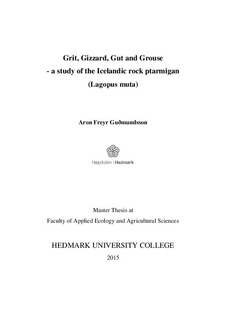| dc.description.abstract | Rock ptarmigan (Lagopus muta) feed on digestively resistant diet which is grinded in the gizzard with help of grit the birds ingest. The composition of the grit in gizzard has previously been observed to change with quality of the food along with the size of the digestive organs, gizzard and gut. The aim of this study was to: 1) investigate the grit characteristic (number, weight and morphology), gizzard mass and gut length of the rock ptarmigan in Iceland; and 2) test if there was inter-annual variation of the grit characteristic, gizzard mass and gut length; and 3) test if there were differences between sex and age classes of the birds. Further, the inter-annual variations, if present, were compared to the changes in the ptarmigan population density. The ptarmigans for the study were collected during the first week of October 2006-2013. The number of grit and their weight was analyzed for each bird along with the morphology parameters: size, ruggedness and roundness. Grit was found in 92% of the birds and significant difference between the sex and age of the bird was detected for some of the grit variables and for the gizzard mass and gut length. The adult males were observed to have the shortest gut and the juveniles the longest. It is likely that the adult males are more dominant territorially and have better access to food of more nutrient quality than females and juveniles. Significant inter-annual variation was detected for all the grit variables. There was also a change in gizzard mass and gut length between years. These changes in the grit variables and in the size of the gizzard mass and gut length may reflect changes in the quality of the food the ptarmigans were consuming between the years. It is possible that these changes in the food affect the population change, which was supported by the observed correlation between roundness of the grit and the population density. The population was highest one year after the grit had the highest value in roundness but high value in roundness is possibly a result of poor quality food. Poor quality food when the population peaked might have resulted in weaker birds and higher mortality, which consequently leads to decrease in the population. | nb_NO |
